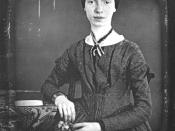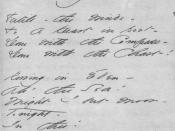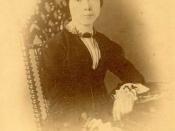In Emily Dickinson?s Tell the Truth but tell it slant there are numerous examples of romanticism such as mystery, emotion, irrationality and surprise. Some of them are obvious, while others require a bit more thought. I will point out both.
In this poem Emily Dickinson shows many examples of mystery. The mystery starts in the name of the poem itself Tell all the Truth but tell it slant. We begin to wonder why she says tell the truth but don?t give all the details leave some things out. We wonder what kind of truth would want to be told but not expressed with details. We understand that the truth seems to be too much for our knowledge .
Emily Dickinson also goes on to tell us the truth must be given gradually, meaning that we need to hear the truth over time.
Emily Dickinson shows emotion when she talks about how we cannot handle the truth all at one time.
She shows emotion to the reader telling us we should be given the truth over time. Another example of emotion is how she describes the easing of the children during lightning.
Another example of romanticism is irrationality. Emily Dickinson uses in the last three lines by telling the reader that she is explaining the truth, but then totally contradicts herself in the next line by telling us that the truth must be told gradually. Another example of irrationality is in the title itself in the way the word truth in the title is capitalized where normally it would be lower case.
The last example of romanticism is surprise which is found throughout the whole poem. Emily Dickinson?s element of surprise is shown in her background. She lived in her house her entire life and still managed to fall in love with two men whom she had never met in her life. This is unusual because its more common to at least have met the person before you fall in love.
In spite of the fact that this poem is brief, there are still many various illustrations of romanticism. I have found that by reading this poem over and over it becomes easier to find and understand all the aspects of romanticism such as mystery, emotion, irrationality, and surprise





